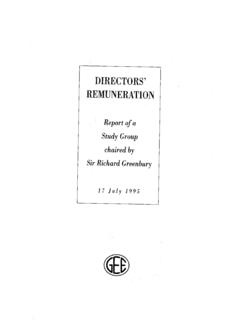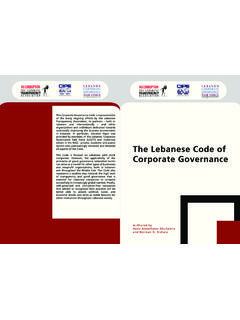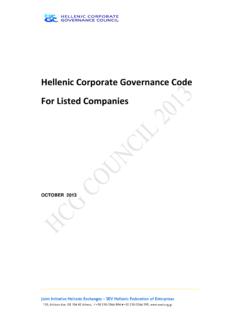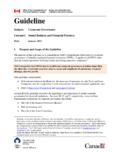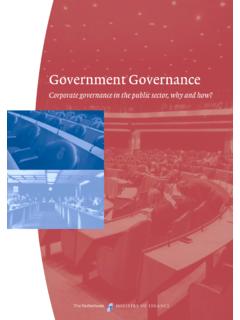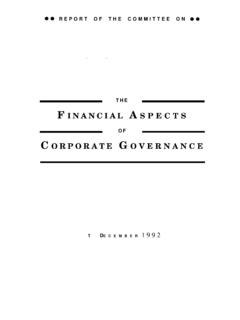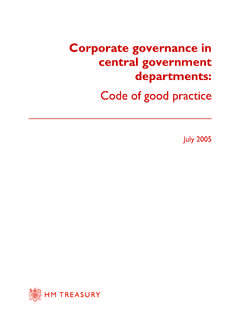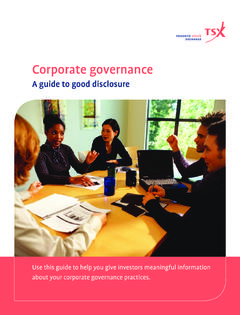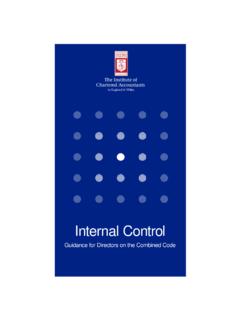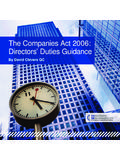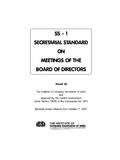Transcription of Review of the role and effectiveness of non …
1 January 2003 Review of the role and effectiveness of non-executive directorsReview of the role and effectiveness of non-executive directorsDerek HiggsJanuary 2003 Further copies of this document are available copies can be obtained from:The Department of Trade and Industry,Room 507,1 Victoria Street,London SW1H 0 ETTelephone enquiries: 020 7215 0409 Published January 2003 Printed in the United Kingdom by The Stationery Office 19585 809438 01/031 PageLetter from Derek Higgs to the Chancellor of the Exchequer and the Secretary of State for Trade and Industry3 Summary of recommendations5 Chapter 1 Introduction11 Chapter 2 Recent developments15 Chapter 3 Conduct of the Review17 Chapter 4 Role of the board21 Chapter 5 Role of the chairman23 Chapter 6 Role of the non-executive director27 Chapter 7 The senior independent director31 Chapter 8 The effective board33 Chapter 9 Independence35 Chapter 10 Recruitment and appointment39 Chapter 11 The well-informed non-executive director47 Chapter 12 Terms of engagement53 Chapter 13 Audit and remuneration committees59 Chapter 14 Liability of non-executive
2 Directors63 Chapter 15 Relationships with shareholders67 Chapter 16 Smaller listed companies71 Chapter 17 Making change happen73 CONTENTSA nnex ASuggested revised Code (incorporating Reviewrecommendations)77 Annex BNon-Code recommendations93 Annex CGuidance for the non-executive director97 Annex DGuidance for the chairman99 Annex ESummary of the principal duties of theremuneration committee101 Annex FSummary of the principal duties of the nominationcommittee103 Annex GPre-appointment due diligence checklist for newboard members105 Annex HSample letter of non-executive directorappointment107 Annex IInduction checklist111 Annex JPerformance evaluation guidance113 Annex KTerms of reference for the Review117 Annex LUseful web links1192 ANNEXESW alter Bagehot famously wrote of the monarchy in 1867: Wemust not let in daylight upon magic.
3 In the corporateboardroom, the importance of the non-executive director isrecognised but their role, perhaps like that of the monarchy ofold, is largely invisible and poorly understood. When corporatestrategies fail or governance lapses, however, attention rightlyfocuses on the contribution of the non-executive a background of corporate turbulence, it is very muchthe purpose of this Review to let in some daylight on the roleof the non-executive director in the boardroom and to makerecommendations to enhance their the work I have done, I am clear that the fundamentalsof corporate governance in the UK are sound, thanks to SirAdrian Cadbury and those who built on his foundations. TheCombined Code and its philosophy of comply or explain isbeing increasingly emulated outside the UK.
4 It offers flexibilityand intelligent discretion and allows for the valid exception tothe sound rule. The brittleness and rigidity of legislation cannotdictate the behaviour, or foster the trust, I believe isfundamental to the effective unitary board and to superiorcorporate from Derek Higgs tothe Chancellor of the Exchequerand the Secretary of State forTrade and IndustryBut the Code can and should regularly evolve to lead bestpractice in the boardroom and raise the bar for the Code was adopted in its present form, the mostprogressive companies have continued to improve the rigourand effectiveness of the work of their boards. As a result manylisted companies exceed its current provisions, and there isevery reason why all companies should aspire to the standardsof the Review has therefore aimed principally to advance andreflect best practice through proposed revisions to the Code.
5 Itincludes focus on the behaviours and relationships, and theneed for the best people, which are essential for an hope that my recommendations will be adopted in earlyrevisions to the Code. I hope, too, that a reader of the Reviewand its associated research will feel that some daylight hasindeed been let in on the workings of the board, magicalor I have achieved this, it is in very large part due to the manyindividuals and organisations who have contributed time,experience and thoughtfulness to the process. In particular,I am indebted to Anne Willcocks of the Department of Tradeand Industry and Andrew Paulson of HM Treasury, and theircolleagues, for their energy, enthusiasm and dedication and notleast for their patience with Higgs20 January 20034 SUMMARY OF RECOMMENDATIONS5 The board The board is collectively responsible for promoting the success of thecompany by leading and directing the company s affairs.
6 A description of therole of the board is proposed for incorporation into the Combined Code (theCode) (Box opening Chapter 4). The number of meetings of the board and of its main committees shouldbe stated in the annual report, together with the attendance of individualdirectors (paragraph ). A description should be included in the annualreport of how the board operates (paragraph ). The board should be of an appropriate size (paragraph ). At least halfthe members of the board, excluding the chairman, should be independentnon-executive directors (paragraph ). There should also be a strongexecutive representation on the board (paragraph ). The chairman The chairman has a pivotal role in creating the conditions for individualdirector and board effectiveness .
7 The Review describes the role of thechairman (Chapter 5) and some of the attributes and behaviours of aneffective chairman (Annex D). The roles of chairman and chief executive should be separated ( ) and the division of responsibilities between the chairman and chiefexecutive set out in writing and agreed by the board (paragraph ). A chief executive should not become chairman of the same company(paragraph ). At the time of appointment the chairman should meet thetest of independence set out in the Review (paragraph ).Role of the non-executive director A description of the role of the non-executive director is proposedfor incorporation into the Code (Box opening Chapter 6). Guidance isoffered for non-executive directors on how to maximise their effectiveness (Annex C).
8 The non-executive directors should meet as a group at least once a yearwithout the chairman or executive directors present and the annual reportshould include a statement on whether such meetings have occurred(paragraph ). Prior to appointment, potential new non-executive directors should carry outdue diligence on the board and on the company to satisfy themselves thatthey have the knowledge, skills, experience and time to make a positivecontribution to the board. Guidance on pre-appointment due diligence isoffered (Annex G). The senior independent director A senior independent director should be identified who meets the test ofindependence set out in the Review . The senior independent director shouldbe available to shareholders, if they have concerns that have not beenresolved through the normal channels of contact with the chairman or chiefexecutive (paragraphs to ).
9 Independence All directors should take decisions objectively in the interests of the company(paragraph ). A definition of independence is proposed for incorporation into the Code(paragraph ).Recruitment and appointment There should be a nomination committee of the board to conduct theprocess for board appointments and make recommendations to the board(paragraph ). The nomination committee should consist of a majority of independent non-executive directors. It may include the chairman of the board, but should bechaired by an independent non-executive director. A statement should bemade in the annual report setting out the composition, terms of reference,and activities of the nomination committee and the process used forappointments (paragraph ). A summary of the principal duties of thenomination committee is offered (Annex F).
10 The nomination committee should evaluate the balance of skills, knowledgeand experience on the board and prepare a description of the role andcapabilities required for a particular appointment (paragraph ). On appointment, non-executive directors should receive a letter setting outwhat is expected of them (paragraph ). A specimen letter of appointmentis offered (Annex H). The nomination committee should provide support to the board onsuccession planning (paragraph ). Chairmen and chief executives should consider implementing executivedevelopment programmes to train and develop suitable individuals in theircompanies for future director roles (paragraph ). 6 The board should set out to shareholders why they believe an individualshould be appointed to a non-executive director role and how they meetthe requirements of the role (paragraph ).

